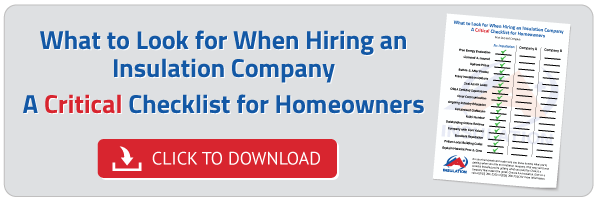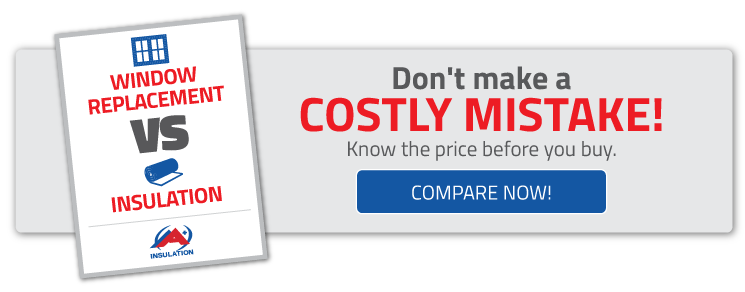 It’s an old saying, but “The devil is in the details” means that mistakes are usually made in the small details of a project. At A+ Insulation, we know that is true. That’s why we pay special attention to the details, to make sure your insulation installation is superior. What details, you ask? Take a peek at the attention to detail we give every insulation job:
It’s an old saying, but “The devil is in the details” means that mistakes are usually made in the small details of a project. At A+ Insulation, we know that is true. That’s why we pay special attention to the details, to make sure your insulation installation is superior. What details, you ask? Take a peek at the attention to detail we give every insulation job:
Energy Evaluation – Every insulation job starts with an energy evaluation. We want to see exactly where your home is leaking air (energy) and make sure we cover every source to make your home as energy efficient as possible.
Education – There are many types of insulation available, and at A+, we offer you many choices. Our experts will fully explain the pros and cons of each type of insulation from batted, to blown-in, to foam. You can make your choice with a full understanding of each product, so you can make the choice that is best for your home and your budget.

Sealing Every Nook & Cranny – Once the insulation is in, it’s hard to see the details underneath it. That’s why, when we seal around every light fixture, plumbing pipe, air duct and vent, we also show you photos of it before the insulation covers it up so you know everything was done to the highest standards – A+ standards.
Related Read: How Do You Know Your Insulation Team Really Did Their Job?
Attic Ventilation – In attics, ventilation is as important as insulation. Improper ventilation will cause moisture problems including mold, mildew, and rot, and can cause ice damming on your roof in the winter. We make sure your attic is properly ventilated as well as insulated.
Related Read: Getting Proper Insulation for Your Attic – It’s a Breeze

Attic Hatches – One of the most common places insulation companies tend to leave uncovered is your attic hatch. At A+, not only do we seal around the attic door, we make sure it is covered with insulation once it’s shut. Otherwise, this leaves a large area for air to escape reducing the efficiency of your insulation overall.
Home Protection – When we install insulation in your attic or walls, we have to bring our equipment into your home to get the job done right. But rest assured, we take every precaution to protect your home. We cover any walls that our hoses may touch with plastic sheeting, cover your floors to keep them clean, and treat your home with the utmost respect. When we leave, there will be no sign that we were there.
Walk-Through – Once the installation is complete, we walk you through your home showing and explaining what we did. We show you pictures of hard-to-get-to places like attics and crawl spaces so you can see exactly what was done in each area. We want you to feel completely confident in our professionalism and our promise.
OSHA Certified Supervisor On Site – With every installation, we have an OSHA certified supervisor on site to make sure that all safety measures are followed during every install.





 Surprises can be great – surprise parties, surprise presents, surprise vacations. But there are some surprises that aren’t so appreciated – surprise accidents, surprise repairs, surprise bills. At A+ Insulation, we know you don’t want any of those kind of surprises.
Surprises can be great – surprise parties, surprise presents, surprise vacations. But there are some surprises that aren’t so appreciated – surprise accidents, surprise repairs, surprise bills. At A+ Insulation, we know you don’t want any of those kind of surprises. Homes use a lot of energy. But just how much does it cost to run your home? The team at A+ Insulation wondered the same thing, so we’re breaking it down for you. As a homeowner, here is where the bulk of your money goes when it comes to energy bills. We looked at a 2013 study by the Lawrence Berkeley National Laboratory for reference. Here’s how it broke down:
Homes use a lot of energy. But just how much does it cost to run your home? The team at A+ Insulation wondered the same thing, so we’re breaking it down for you. As a homeowner, here is where the bulk of your money goes when it comes to energy bills. We looked at a 2013 study by the Lawrence Berkeley National Laboratory for reference. Here’s how it broke down:
 It’s fair to say that everyone would like to save money on energy bills. But what can you do to make that a reality? The team at A+ Insulation put together this list of doable things that will keep your energy bills lower this summer.
It’s fair to say that everyone would like to save money on energy bills. But what can you do to make that a reality? The team at A+ Insulation put together this list of doable things that will keep your energy bills lower this summer. It’s safe to say that, Grog & Og did not have insulation in their cave. They were too busy trying to survive by hunting and not getting eaten to worry about freezing to death. Fire simply had to do when it came to warmth.
It’s safe to say that, Grog & Og did not have insulation in their cave. They were too busy trying to survive by hunting and not getting eaten to worry about freezing to death. Fire simply had to do when it came to warmth. A home that is not properly insulated will not only feel drafty, but it will also have some pretty hefty heating and cooling bills. If you suspect your home is under insulated, it may behoove you to do your own homeowner insulation inspection. There are several areas that are fairly easy to inspect. The insulation pros at A+ Insulation will walk you through the basics so that you can do your own insulation inspection.
A home that is not properly insulated will not only feel drafty, but it will also have some pretty hefty heating and cooling bills. If you suspect your home is under insulated, it may behoove you to do your own homeowner insulation inspection. There are several areas that are fairly easy to inspect. The insulation pros at A+ Insulation will walk you through the basics so that you can do your own insulation inspection. Making your home more energy efficient will save you hundreds, if not thousands, of dollars a year if done properly. Using caulk to seal holes where heat and air escape is a great step toward having a more energy efficient home. Below are several tips from the pros at A+ Insulation for caulking your home.
Making your home more energy efficient will save you hundreds, if not thousands, of dollars a year if done properly. Using caulk to seal holes where heat and air escape is a great step toward having a more energy efficient home. Below are several tips from the pros at A+ Insulation for caulking your home. Unless your home was specially constructed for energy efficiency, you can probably reduce your energy bills by adding more insulation. This is especially true if your home is older, but even adding insulation to a newer home can pay for itself in just a few years. There are some special considerations in each area of your home when it comes to insulation installation. This article from the insulation professionals at A+ Insulation will give you some tips on insulating a cathedral ceiling.
Unless your home was specially constructed for energy efficiency, you can probably reduce your energy bills by adding more insulation. This is especially true if your home is older, but even adding insulation to a newer home can pay for itself in just a few years. There are some special considerations in each area of your home when it comes to insulation installation. This article from the insulation professionals at A+ Insulation will give you some tips on insulating a cathedral ceiling. When properly installed, insulation keeps your home at a uniform temperature and reduces heating and cooling costs. Insulation is found behind each interior wall in the home and is often left uncovered in attics and crawlspaces. Did you know that 90% of homes in the US are under-insulated? With that in mind, the insulation experts at A+ Insulation wanted to share some information with homeowners about evaluating the insulation in your home. How do you know if you have enough insulation in your attic, your walls, crawl spaces, or basement? Read on to discover the best way to check your home’s energy efficiency and the best way to add insulation to areas that need more.
When properly installed, insulation keeps your home at a uniform temperature and reduces heating and cooling costs. Insulation is found behind each interior wall in the home and is often left uncovered in attics and crawlspaces. Did you know that 90% of homes in the US are under-insulated? With that in mind, the insulation experts at A+ Insulation wanted to share some information with homeowners about evaluating the insulation in your home. How do you know if you have enough insulation in your attic, your walls, crawl spaces, or basement? Read on to discover the best way to check your home’s energy efficiency and the best way to add insulation to areas that need more.